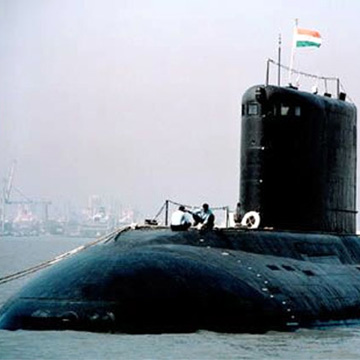 New Delhi:
New Delhi: The Indian Navy's design bureau is favourably considering nuclear propulsion for the second, and possibly a third indigenous aircraft carrier.
Although the final decision is yet to be taken, reliable sources told India Strategic (
www.indiastrategic.in) that the navy and the country's nuclear scientists have drawn sufficient experience from their success in installing nuclear propulsion in Arihant, the country's first SSBN (ship submersible ballistic nuclear) submarine (or nuclear-propelled, nuclear-armed submarine), which is currently undergoing sea trials, and that is encouraging them to replicate the technology for indigenous aircraft carriers.
Right now, according to the navy chief, Admiral Robin Dhowan, the Naval Design Bureau (NDB) is working towards designing a 60,000 -65,000 tonne aircraft carrier - which will be the biggest vessel to be constructed in the country - and that two major systems under consideration are nuclear propulsion and the new generation aircraft launch system, EMALS (Electromagnetic Aircraft Launch and Recovery System), from the US General Atomics. But there is no final decision yet on either.
India's first indigenous aircraft carrier, IAC-I or Vikrant, is under construction at the Kochi Shipyard for delivery by end-2018 and it is to be propelled by four LM2500 gas turbine engines from the US GE. Nuclear power is being considered for the second, called IAC-II and likely to be named Vishal. It is planned for induction in 2029.
There is also the strong possibility of another indigenous carrier, IAC-III.
While the IAC-I has a ski-jump to launch aircraft, IAC-II and IAC-III will likely use the EMALS to catapult aircraft from short distances of the carrier decks.
The Indian Navy is looking at three aircraft carriers to ensure 24x7 operations with two Carrier Battle Groups (CBGs). Three carriers are required as one of them will be under periodic maintenance and refits, and accordingly, unavailable.
At present, the Indian Navy has Russia-supplied INS Vikramaditya since 2013, and it should be in service for about 30 to 35 years. India will need its third indigenous carrier by then, and it takes some 10 years to build one, even with new modular construction practices.
Both INS Vikramaditya and IAC-I share the ski-jump system to launch Russian-made MiG 29K aircraft. The EMALS will be much more efficient and powerful to launch different aircraft in moments with the flick of a switch. The US Navy is using the system for its new generation carriers, the Gerald R. Ford (under construction) and John F Kennedy.
As for the IAC-2, sources told India Strategic that the Ministry of Defence (MoD) is set to initiate the first formal step towards according its official sanction by allotting funds to authorize and complete a study on requirements.
The second step, a big one, is likely within 2016 in the form of Acceptance of Necessity (AON). That will mean the official go-ahead from the government to start work and funding will be allotted in accordance with the pace of development and construction.
Notably, while the US government is already working on sharing the EMALS technology with the Indian Navy, development and complex installation of nuclear propulsion will have to be done by the Indians themselves. That is where the success in installing nuclear propulsion in Arihant using low enriched uranium (LEU) offers the incentive and inspiration.
The NDB and scientists from DRDO (Defence Research and Development Organisation) and BARC (Bhabha Atomic Research Centre) are systematically coordinating on this.
Notably again, the US carriers use bomb-grade highly-enriched uranium (HEU) after mastering the technology decades ago. The US Navy is the only one to do so, and apparently will be unwilling to share this expertise. The HEU-propelled vessels have a big advantage as they can go on for 20 to 40 years or more while LEU-propelled ships have to be refuelled every five years or so.
Significantly, Arihant has successfully completed several propulsion and diving trials, and right now, is conducting a series of final tests to launch unarmed missiles from different depths before its likely induction in the coming few weeks.
Subject to the success, it will be given a warship pennant number, declared it is operational, and then be cleared for participation in the International Fleet Review (IFR) scheduled for February 2016.
Admiral Dhowan has expressed hope on this, but understandably has been non-committal as even minor tests on board nuclear vessels are critical and nothing is accepted without total success, notwithstanding any time delays.
The Indian Navy already has clearance to build six SSN (nuclear-propelled but not nuclear-armed) submarines and indications are that two to three more SSBN Arihant class vessels are also under different stages of construction - and that they will be larger, and with more powerful nuclear reactors than that of Arihant.
Progression to building nuclear reactors for aircraft carriers is logical, particularly as fossil fuel-powered vessels are dependent on a continuous supply of oil irrespective of the growing cost factors as well as the emerging threats in the Indian Ocean.
China, for instance, has acquired Gwadar from Pakistan to serve both as a commercial port and a naval base, becoming the first foreign power to have this facility so near the Indian shores and the strategic Strait of Hormuz, from where nearly half the world's oil comes through.
The US also has a major base at Diego Garcia in the Indian Ocean, but about 2,400 km from India's southern state of Tamil Nadu.
# Gulshan Luthra writes on strategic affairs. He can be contacted at gulshan.luthra@indiastrategic.in
 New Delhi: The Indian Navy's design bureau is favourably considering nuclear propulsion for the second, and possibly a third indigenous aircraft carrier.
New Delhi: The Indian Navy's design bureau is favourably considering nuclear propulsion for the second, and possibly a third indigenous aircraft carrier.